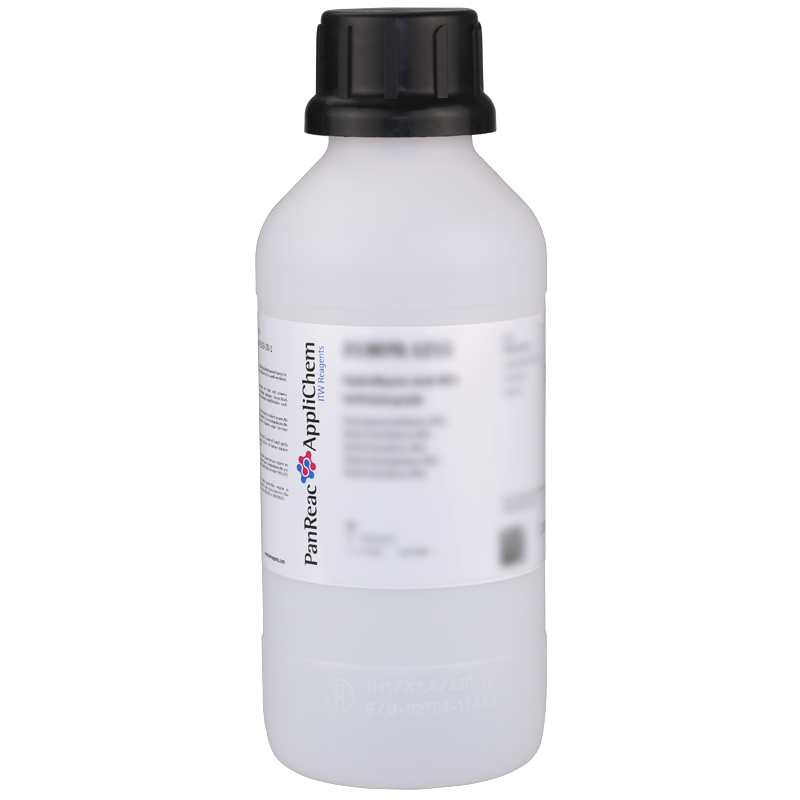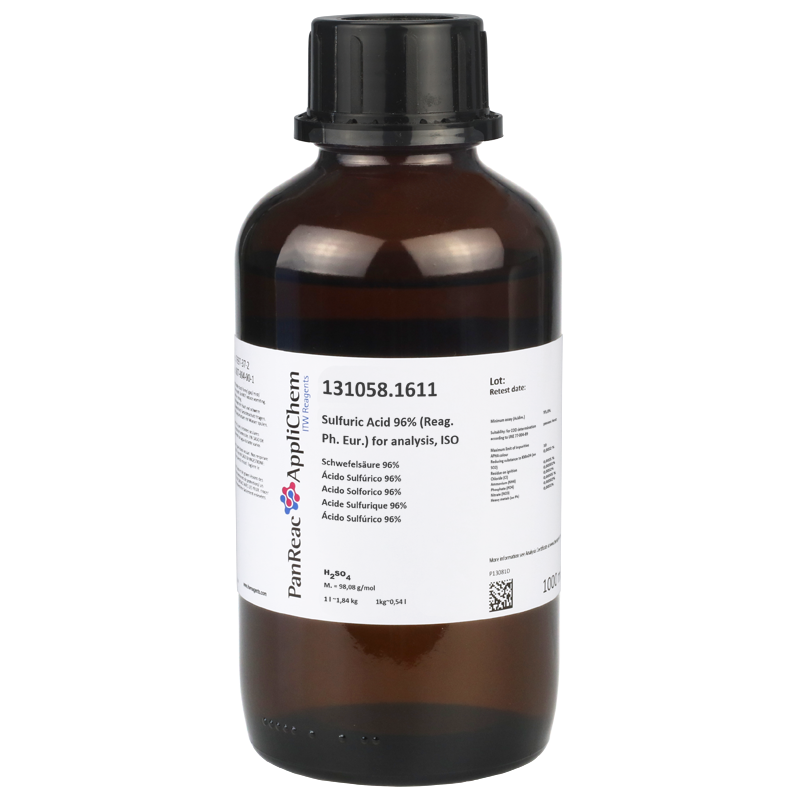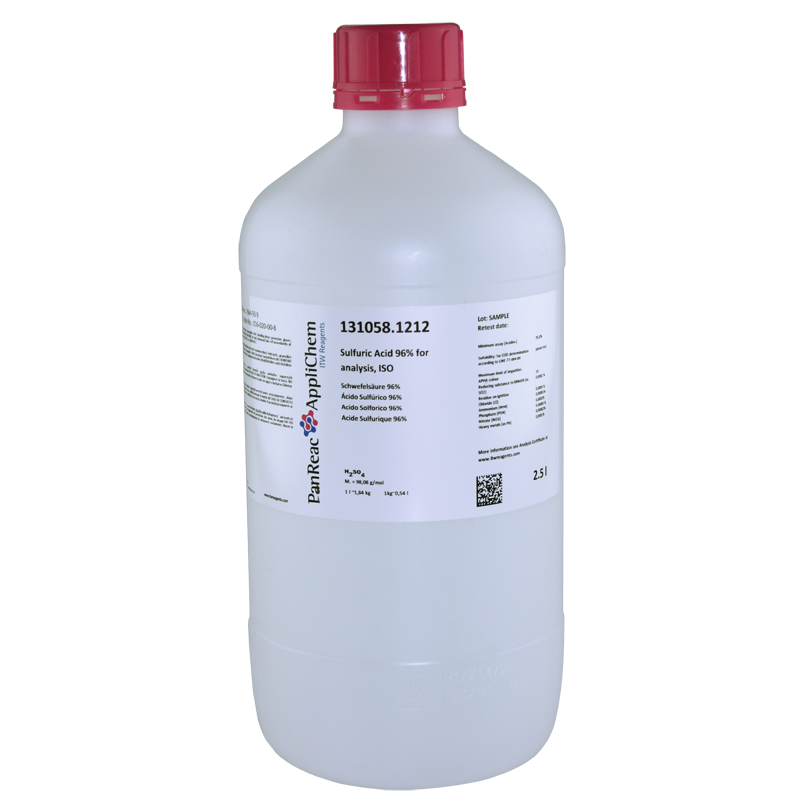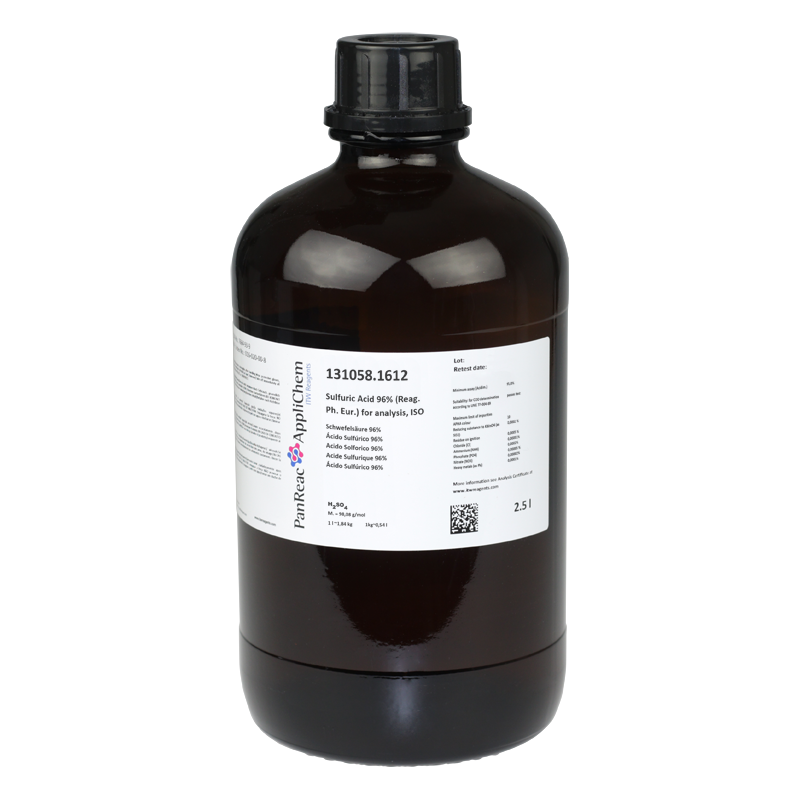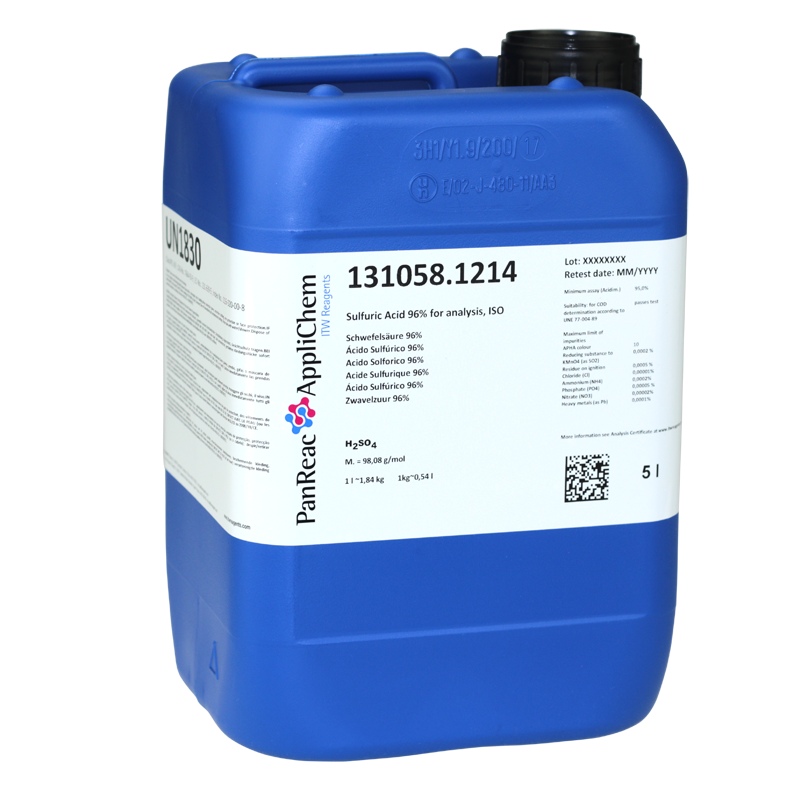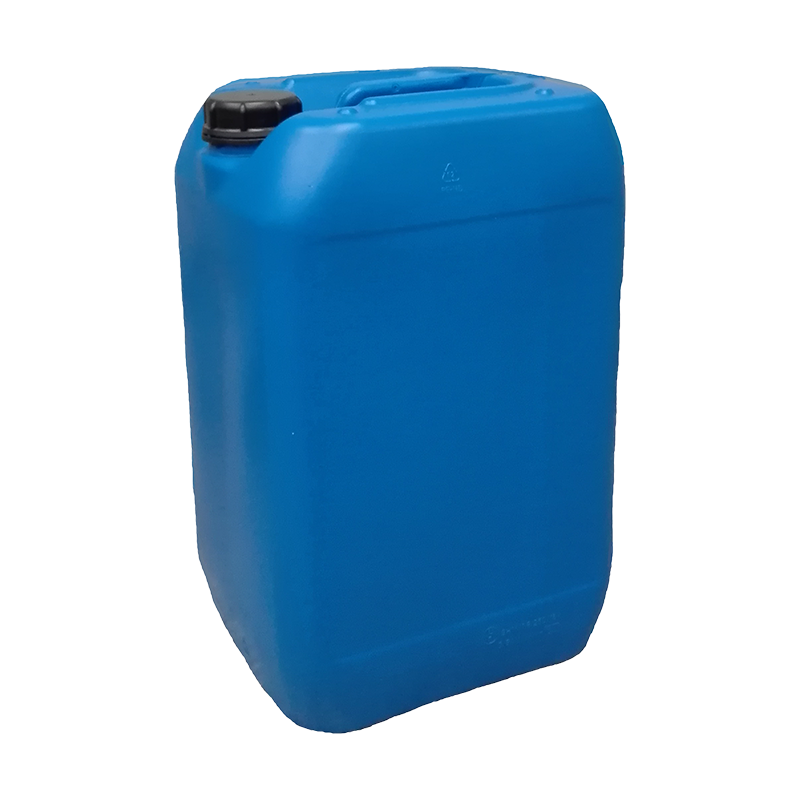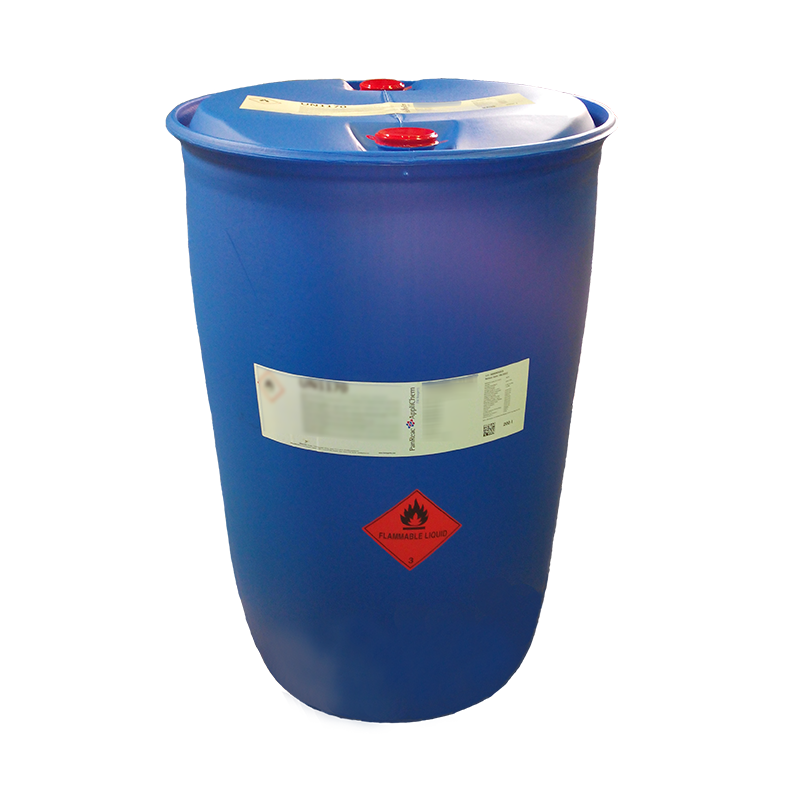Packs sizes (7)
| code | packaging size | price per unit | box price per unit | |
|---|---|---|---|---|
| Code & packaging | Price per piece | |||

|
code
131058.1211
|
packaging size
1000 ml
|
Product active until stock lasts.
|
|

|
code
131058.1611
|
packaging size
1000 ml
|
price per unit
single
29,10€
|
box price per unit
24,74€x 6 units
|

|
code
131058.1212
|
packaging size
2.5 l
|
price per unit
single
52,90€
|
box price per unit
44,96€x 4 units
|

|
code
131058.1612
|
packaging size
2.5 l
|
price per unit
single
54,10€
|
box price per unit
45,99€x 4 units
|

|
code
131058.1214
|
packaging size
5 l
|
price per unit
single
103,40€
|
box price per unit
87,89€x 4 units
|

|
code
131058.0716
|
packaging size
25 l
|
price per unit
single
290,80€
|
box price per unit
|

|
code
131058.0719
|
packaging size
200 l
|
price per unit
single
Request a quote
|
box price per unit
|
Technical data
- Melting Point:
- -15 °C
- Boiling Point:
- 330 °C
- Density:
- 1.84 kg/l
- Physical Description:
- liquid
- Product Code:
- 131058
- Product Name:
- Sulfuric Acid 95-97% (max. 0.0000005% Hg) (Reag. Ph. Eur., USP) for analysis, ACS, ISO
- Quality Name:
- for analysis, ACS, ISO
- Specifications:
- Assay (Acidim.): 95.0% - 97.0%
Maximum limit of impurities
APHA colour: 10
Reducing substance to KMnO4 (as SO2): 0.0002 %
Residue on ignition: 0.0005 %
Chloride (Cl): 0.00001%
Ammonium (NH4): 0.0002%
Phosphate (PO4): 0.00005 %
Nitrate (NO3): 0.00002%
Heavy metals (as Pb): 0.0001%
- Hazard pictograms
-
- UN:
- 1830
- Class/PG:
- 8/II
- ADR:
- 8/II
- IMDG:
- 8/II
- IATA:
- 8/II
- WGK:
- 1
- Storage:
- Room Temperature.
- Signal Word:
- Danger
- GHS Symbols:
- GHS05
- H Phrases:
- H314
- P Phrases:
- P260
P264
P280
P301+P330+P331
P303+P361+P353
P501
P304+P340
P305+P351+P338
P310
P321
P338
P363
P405
- Master Name:
- Sulfuric Acid 93-98%
- EINECS:
- 231-639-5
- CS:
- 2807 00 00 00
- Index Nr.:
- 016-020-00-8
Documents
Inquiry
Comments
Sulfuric acid is a chemical compound of sulfur with the molecular formula H2SO4. The 100% sulfuric acid is a colorless, oily, very viscous and hygroscopic liquid, which is sometimes called monohydrate in engineering. Sulfuric acid is one of the strongest acids and is highly corrosive. This mineral acid forms two series of salts, the hydrogen sulfates and the sulfates, in which one and two protons, respectively, are replaced by cations compared to the free acid.Sulfuric acid is one of the most technically important chemicals of all and is one of the most widely produced basic chemical substances. In 1993, about 135 million tons[9] of sulfuric acid were produced worldwide; in 2012, the figure was 230 million tons. It is mainly used in fertilizer production and for the production of other mineral acids, such as hydrochloric or phosphoric acid. Aqueous solutions of various concentrations are mostly used.
The anhydride of sulfuric acid is sulfur trioxide (SO3). The solution of sulfur trioxide in the sulfuric acid beyond the stoichiometric ratio is called fuming sulfuric acid or oleum. Related acids are sulfurous acid (H2SO3), which is derived from sulfur dioxide, and thiosulfuric acid (H2S2O3), in which one oxygen atom is replaced by sulfur.
History
Sulfuric acid has been known under the obsolete name vitriol oil for a long time. The first references are found in the texts of the historically disputed alchemist Dschābir ibn Hayyān from the 8th century. After that, possible manufacturing processes are also mentioned in the alchemical writings of Albertus Magnus (1200-1280) and Basilius Valentinus (around 1600). These processes describe how vitriol oil can be obtained from naturally occurring sulfates - such as chalcanthite or alum. The name vitriol oil is derived from the obsolete name vitriol for these minerals. The first source of larger quantities of sulfuric acid was iron vitriol. Starting in the 16th century, sulfuric acid was produced in Bohemia, Saxony, and the Harz Mountains using the vitriol process. The product was called Nordhausen vitriol after the first place of production, Nordhausen. Johann Rudolph Glauber conducted the first scientific investigations with sulfuric acid. He allowed the acid to act on common salt, obtaining hydrochloric acid and Glauber's salt sodium sulfate, which was named after him.
However, the processes in which sulfates were used were very complex and expensive. To obtain larger quantities, a process was developed in the 18th century in which sulfur and saltpeter were burned in glass vessels. Since the glass vessels were very fragile, the reaction was first carried out in lead containers in 1746 by John Roebuck. In 1778, the first chemical factory in Switzerland was founded in Winterthur with the laboratory, which produced vitriol oil as its main product. After Nicolas Clément-Désormes and Charles-Bernard Desormes discovered in 1793 that the amount of saltpeter could be significantly reduced by using air, the lead chamber process could be used on a large scale. This was particularly important for the Leblanc process for soda ash production, invented by Nicolas Leblanc in 1789 and first used by him in 1791. The process was improved several times, for example by the development of methods for absorbing nitrous gases by Joseph Louis Gay-Lussac. It was thus possible to achieve continuous production control.
The main disadvantage of this process was that only a maximum acid concentration of 78% was achievable, and more concentrated solutions and oleum still had to be produced via the laborious distillation of iron vitriol. Simple production of higher-concentration sulfuric acid was only achieved after the development of the contact process from 1870 by Rudolph Messel in England.
Occurrence
Free sulfuric acid, not dissociated into oxonium and sulfate ions, occurs only very rarely in nature. In the atmosphere it is formed from sulfur dioxide, which is produced during the combustion of sulfur-containing substances or during volcanic eruptions. The sulfur dioxide is oxidized by hydroxyl radicals and oxygen to sulfur trioxide. With water, free sulfuric acid is finally formed. Other oxidizing agents that allow sulfur trioxide to form are ozone or hydrogen peroxide. It then reaches the earth in acid rain in the form of dilute acid.
A small amount of free sulfuric acid also occurs in some volcanic springs called solfataras.
Unlike free acid, its salts, especially sulfates, are much more common in nature. Many different sulfate minerals exist. Among the best known and most important are gypsum (CaSO4 - 2 H2O), barite (BaSO4), chalcanthite (CuSO4 - 5 H2O) or Glauber's salt (Na2SO4 - 10 H2O).
Outside the Earth, sulfuric acid is found in the upper atmosphere of Venus. This is formed by photochemical reactions of sulfur dioxide and water. Droplets are formed that contain 80-85% sulfuric acid. In deeper layers, the high temperatures cause the acid to decompose into sulfur dioxide, oxygen, and water, which can rise again to form sulfuric acid.
Extraction and production
The basic material for sulfuric acid production is often elemental sulfur, which is produced in large quantities (2007: 66 million metric tons) during the desulfurization of natural gas and crude oil and is processed using the Claus process or mined using the Frasch process. The sulfur is burned to produce sulfur dioxide as a feedstock for the actual process.
S + O 2 ⟶ SO 2
Another source that produces large amounts of sulfur dioxide is the smelting of sulfur-containing ores. Examples include copper, zinc, or lead smelting from the corresponding sulfides. The sulfur dioxide is formed during roasting with atmospheric oxygen.
2 ZnS + 3 O 2 ⟶ 2 ZnO + 2 SO 2
In 1999, three million tons of pyrite were still roasted in Europe for sulfuric acid production. In Asia, however, the proportion of pyrite is higher.
For resource-poor countries that have neither sulfur nor sulfide ores, the production of gypsum sulfuric acid using the Müller-Kühne process is an option. In this process, sulfur dioxide is extracted from gypsum and coal in a rotary kiln. The energy-intensive process can be made more profitable if cement is produced as a by-product by adding sand and clay. In the GDR, the process was carried out on a large scale.
For further production, sulfur trioxide must be obtained from the sulfur dioxide. The direct reaction of sulfur and oxygen to sulfur trioxide takes place only to a small extent, since the equilibrium in the reaction of sulfur dioxide to sulfur trioxide is on the side of sulfur trioxide only at low temperatures. At these temperatures, however, the reaction rate is too low. Therefore, with the aid of suitable catalysts, the reaction must be controlled in such a way that a sufficiently fast reaction is ensured at temperatures that are not too high.
In the contact process, which is still used exclusively, vanadium pentoxide is used as the oxygen-transferring catalyst. A molten salt is formed from vanadium(V) oxide and alkali metal sulfates added as co-catalysts. The reactive complex with the composition [(VO)2O(SO4)4]4-, which acts as the actual catalyst, is formed in this melt. Oxygen and sulfur dioxide attach to this without changing the oxidation number of the vanadium and react to form sulfur trioxide.
2 SO 2 + O 2 ↽ - - ⇀ 2 SO 3
The temperature during the reaction must be between 420 and 620 °C, since at lower temperatures the catalyst becomes inactive due to the formation of vanadium(IV) compounds, and it decomposes at higher temperatures. The reaction is carried out in so-called tray contact furnaces, in which the catalyst is arranged in a total of four layers (the "trays") one above the other, and the gas flowing through is cooled to the appropriate temperature between the trays.
In the contact process, which is still used exclusively, vanadium pentoxide is used as an oxygen-transferring catalyst. A molten salt is formed from vanadium(V) oxide and alkali metal sulfates added as co-catalysts. The reactive complex with the composition [(VO)2O(SO4)4]4-, which acts as the actual catalyst, is formed in this melt. Oxygen and sulfur dioxide attach to this without changing the oxidation number of the vanadium and react to form sulfur trioxide.
The temperature during the reaction must be between 420 and 620 °C, since at lower temperatures the catalyst becomes inactive due to the formation of vanadium(IV) compounds, and it decomposes at higher temperatures. The reaction is carried out in so-called tray contact furnaces, in which the catalyst is arranged in a total of four layers (the "trays") one above the other, and the gas flowing through is cooled to the appropriate temperature between the trays.
In the so-called double-contact process, the sulfur trioxide present is washed out with concentrated sulfuric acid before the last tray. This enables the yield to be increased to at least 99.8% (First General Administrative Regulation on the Federal Immission Control Act, Technical Instructions on Air Quality Control 2002).
After formation of the sulfur trioxide, it is converted to sulfuric acid. For this purpose, remaining sulfur dioxide must first be removed with ammonia or sodium thiosulfate. Since the direct reaction of sulfur trioxide with water is too slow, the gas is passed into concentrated sulfuric acid. In this process, disulfuric acid H2S2O7 is quickly formed. When this is diluted with water, it decomposes to two molecules of sulfuric acid.
SO 3 + H 2 SO 4 ⟶ H 2 S 2 O 7
Reaction of sulfur trioxide with sulfuric acid
H 2 S 2 O 7 + H 2 O ⟶ 2 H 2 SO 4
Formation of sulfuric acid
This process does not produce pure sulfuric acid, but concentrated acid with 98% acidity. To produce pure sulfuric acid, the amount of sulfur trioxide that corresponds to the amount of substance of the excess water of the concentrated acid must be introduced into the concentrated acid.
In recent decades, sulfuric acid production has increased sharply, especially in China, while in European countries such as Germany, production has declined. Since the early 2000s, China has relied on additional quantities from Europe. The sharp upheavals in 1990 and 1991 seen in the graph are due to the breakup of the Soviet Union and a change in statistics in the United States. China's production of sulfuric acid has increased significantly in recent years.
Of considerable economic importance in the large-scale industrial production of sulfuric acid is that the three individual steps are exothermic (for values, see Contact Processes). The amount of heat released is used to generate high-pressure steam for power generation and industrial heating purposes.
Physical properties
Anhydrous sulfuric acid is a viscous (cross-linked by H-bridges), colorless liquid with high density (1.8269 g/cm³) that solidifies below 10.371 °C. The melting point is greatly lowered by small amounts of water and is, for example, 3.0 °C for a 98% sulfuric acid. The frequent light brown coloration of technical sulfuric acid is due to organic impurities that are carbonized by dehydration. Above the boiling point of 279.6 °C of anhydrous sulfuric acid, sulfuric acid vapors form containing excess sulfur trioxide, with the water remaining in the boiling sulfuric acid. The anhydrous sulfuric acid thus passes to a 98.33% sulfuric acid with a constant boiling point of 338 °C. At this temperature, the vapor also has an acid content of 98.33% and thus corresponds to an azeotropic water-sulfuric acid mixture. An acid of the same composition and boiling point is obtained when dilute acid is distilled. 100% sulfuric acid can therefore not be obtained by distilling dilute sulfuric acid, but only by dissolving a certain amount of sulfur trioxide in concentrated sulfuric acid. When heated further above 338 °C, sulfuric acid decomposes into water and sulfur trioxide ("fuming of sulfuric acid") and is nearly completely dissociated at 450 °C.
As a solid, sulfuric acid crystallizes in the monoclinic crystal system in space group C2/c (space group no. 15). The lattice parameters are a = 814 pm, b = 470 pm, c = 854 pm and β = 111°. The structure is a wavy layered structure in which each dihydrogensulfate tetrahedron is connected to four other tetrahedra by hydrogen bonds. In addition to crystalline pure sulfuric acid, several sulfuric acid hydrates are known. One example is the dihydrate H2SO4 - 2 H2O, which also crystallizes monoclinically with the space group C2/c (No. 15). A total of six different hydrates with one, two, three, four, six, and eight equivalents of water are known in which the acid is completely split into oxonium and sulfate ions. The oxonium ions are associated with a different number of water molecules depending on the hydrate. The melting point of these hydrates decreases as the number of water molecules increases. Thus, the monohydrate melts at 8.59 °C, while the octahydrate melts at -62 °C already.
Strong hydrogen bonds act between the individual molecules, which cause the high viscosity of 24.6 mPa-s at 25 °C. By comparison, water has a much lower viscosity of 0.89 mPa-s at 25 °C.
Similar to pure water, pure sulfuric acid conducts electricity to a small extent. The specific conductivity is 1.044 - 10-2 S/cm. The reason for this is the low dissociation of the acid due to autoprotolysis. Dilute acid, on the other hand, conducts electric current well because of the oxonium ions it contains.
2 H 2 SO 4 ↽ - - ⇀ HSO 4 - + H 3 SO 4 +
Single sulfuric acid molecules are present in the gas phase. These are tetrahedral in structure with bond angles of 101.3° between the OH groups and 123.3° between the oxygen atoms. The bond lengths of the sulfur-oxygen bonds are different with 157.4 pm (to OH groups) and 142.2 pm (to oxygen atoms), respectively. The molecular structure in the solid state corresponds to that in the gas phase.
The bonds in the sulfuric acid molecule can be described by various mesomeric boundary structures. For example, the structure in which double bonds are assumed between sulfur and oxygen or in which there are only single bonds and simultaneous charge separation. Theoretical calculations have shown that the 3d orbitals contribute very little to the bonding. Therefore, the real bonding situation in the sulfuric acid molecule is most accurately described by the structure in which only single bonds are drawn. The shortened S-O bond can be explained by additional electrostatic interactions between the charged atoms.
Chemical properties
As a very strong acid, sulfuric acid readily releases protons. With a pKs value of -3.0 (but this applies only to dilute solutions) or, more precisely, an H0 value of -11.9, sulfuric acid is one of the strong acids in the first protolysis stage.
H 2 SO 4 + H 2 O ⟶ HSO 4 - + H 3 O +
It is not usually counted among the superacids, but it is chosen as the starting point for the definition of superacid: All acids that are stronger than pure sulfuric acid and thus can protonate it are called superacids.
The second protolysis step from hydrogen sulfate to sulfate has a pKs value of 1.9, so the hydrogen sulfate ion is only a moderately strong acid.
HSO 4 - + H 2 O ⟶ SO 4 2 - + H 3 O +
For this reason, hydrogen sulfate is present for the most part in dilute sulfuric acid (concentration about 1 mol/l). The H2SO4 molecule is almost completely dissociated, while the reaction to form the sulfate takes place only to a small extent (about 1.3% at 1 mol/l). Only at higher dilutions are larger amounts of sulfate formed.
Sulfuric acid has a high affinity for water. When acid and water are mixed, various hydrates of the form H2SO4 - n H2O (n = 1-4, 6, 8) are formed under strong heat generation. The strong affinity of sulfuric acid for water is also manifested in its ability to remove hydroxyl groups and protons from organic substances. This removal leaves carbon behind, and the organic substance turns black and carbonized. This effect occurs mainly with substances that contain many hydroxyl groups. Examples are many carbohydrates such as glucose or polysaccharides. Furthermore, the large water affinity can be used for condensation reactions. Here, water is removed from an organic compound without carbonization. An example of this is the synthesis of 2-pyrone.
Another indication of the strong hygroscopicity is that the acid self-dehydrates to a small extent:
2 H 2 SO 4 ↽ - - ⇀ H 3 O + + HS 2 O 7 -
Concentrated sulfuric acid has an oxidizing effect and is capable of dissolving more noble metals such as copper, mercury or silver when heated. In the process, the sulfuric acid is reduced to sulfur dioxide. In contrast, even pure, base iron is not attacked by passivation of concentrated sulfuric acid.
Cu + 2 H 2 SO 4 ⟶ CuSO 4 + SO 2 + 2 H 2 O
Dilute sulfuric acid, on the other hand, has only a slight oxidative effect, since the reaction to sulfur dioxide is inhibited by the solvent water. Only those metals are oxidized or dissolved which, as base elements, can be oxidized by the reaction of protons to hydrogen.
Synonyms of Sulfuric Acid: Dihydrogensulfate, Hydrogen Tetraoxosulfate(VI), Oil of Vitriol, Hydrogen Sulfate, H2SO4



